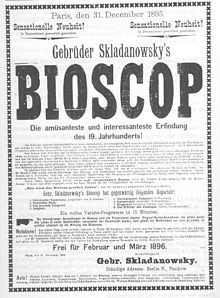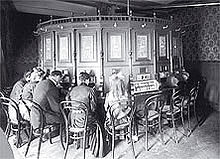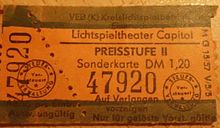Cinema in Eisenach
The article Kinos in Eisenach deals with the origins and development of cinemas in the city of Eisenach .
Show booths and peep boxes
From the middle of the 19th century, the attractions offered at Eisenach fairs, rifle festivals and for popular amusement were enriched by show booths with mechanically movable equipment and optical devices - in the vernacular, peep boxes - which are enjoying growing popularity. The Eisenacher Tageblatt reported about the KINESCOPE by W. Glüers, Microscopic Institute in Berlin, Gipsstrasse 4 , as the latest patented invention.
"These extremely elegantly equipped devices contain mechanically moving photographs, which produce the most perfect optical illusion in that the life-size people appear completely free and naturally mobile."
Showmen with world and imperial panoramas appeared regularly in Eisenach. In addition to their own demonstration tents and show booths, rented rooms were used in the Eisenach inns and variety tea theaters. On December 8th and 9th, 1883, Friedrich Thiele's giant change diorama was a guest at the KONZERTHAUS-CLEMDA
"Consisting of 20-foot-large transparent sculptures with electrical lighting and 175 transformations, animated by moving figures, etc. ..."
The event lasted two hours and the repertoire included: “The Sea and its Miracles”, “The Pied Piper of Hameln”, “The Erlkönig”, “The Mother's Prayer”, “The Loreley” and, as a documentary, “Der Brand des Wiener Ring Theaters ».
In TIVOLI GARDEN guest appearances from 17 to 22 July 1884 Professor H. Anotellis Theater Dissolving views
"A demonstration of the luna-electric original giant light tableaux , consisting of 200 transformations of the most brilliant sculptures from all areas of the earth ..."
At the same garden concert, the following were shown: “In flight through the world”, “The Pied Piper of Hameln” and “The fairy tale of the stork”.
In the garden of RECREATION EHG Beisner made a guest appearance with his Kosmorama-Theater on October 30th and 31st, 1886, he owned a Drumondian Agioskopisches splendid change tableaux . The standard program of the Kosmorama included travel impressions from all over the world as well as fairy tales: Rübezahl, the great mountain spirit and Princess Emma in the Giant Mountains, as well as humorous scenes and graphic color games.
Traveling cinemas (1898–1911)

On February 16, 1897, 15 ½ months after Max Skladanowsky's film premiere in the WINTERGARTEN in Berlin , the first performance with Edison's Ideal Kinetograph was staged under the motto The living photography, the most wonderful exhibition of the century , in the small hall of the TIVOLI in Eisenach. The program consisted of the short films: On the boulevard in Brussels , arrival of a steamer in the port of Hamburg , serpentine dancer , arrival of a train in a Paris suburb , Place de la Republique in Paris and miming, mostly comic representations. A local reporter from Eisenach: "The effect of the pictures is downright surprising and astonishing".
In the following years numerous traveling cinemas made guest appearances in Eisenach: 1903 Blaser's Biograph-Giant- Kinematograph in its own “magnificent building” with a repertoire of 500 films; 1904 to 1906 Fricks phono-cinematograph ; 1907 and 1908 L. Ohr , who showed the first documentary film strips from Eisenach as a special attraction: Life and goings-on at the Reutervilla , on Karlsplatz and adjacent streets , a tour of the Schützenfestplatz , exit from the Marktkirche on Sunday morning and a ride on the Tram . These "great, razor-sharp shots, on which everyone was clearly visible ..." were the talk of the day in town.
Due to technical improvements and constant delivery of new films, film locations were created as additional entertainment options in the Eisenach restaurants and inns - Edison's Thaumatograph , which prevented the problem of image flickering , Mesters Bioskop from the Bioskop Campagnie Charlottenburg-Berlin and the optical system developed in the Kade workshop in Zwickau -physical-apparatus for splendid performances . The presentation of Th. Windorf from Berlin at TIVOLI in November 1903 was particularly successful - with 50 short films, mostly travel and documentary films, including the half-hour trip to the moon or the year 2000 - perhaps the first utopian film in Eisenach? In 1905 M. Faßbender from the Institute Electrographia-Leipzig made a guest appearance with his huge program of great miracles of phono-cinematographic sensational performances and Th. Scherff from the German Bioscope Institute Leipzig-Berlin , HJ Fey from Leipzig and again Fricks Kinematograph - who had already made the film «Der Hauptmann von Cöpenick »had in the program.
The early days of the Eisenach cinemas (1907–1920)
World Theater (Frauenberg 13)
Encouraged by the success of the traveling cinemas, the first Eisenach cinema was opened in the Frauenberg 13 building on November 2, 1907 - it was called Welt-Kinematograph - abbreviated to Welttheater from 1909 - and was managed by Mr. Alfred Edling and from February 7, 1908 by Mrs. Auguste Riesenberg headed. The Eisenacher Zeitung printed the program in the event information. The first films included: “The Drama of Seville (report on the bullfight)”, “A true incident”, “The first exit of a cyclist” and “Recordings from German Southwest Africa”. At times, a colored man was even hired as the bouncer of the cinema. Due to complaints from tenants about constant noise, the Welttheater had to move to Cafe Kaiser , Goldschmiedenstrasse 14, on October 3, 1909 .
Salon Cinephon Theater (Bahnhofstrasse 33)
As a branch of the Leipzig film theater Colosseum , Feys Salon-Cinephon-Theater opened on May 16, 1909 at the train station , with a program that changes twice a week. A broad entertainment program was offered: The Wicked Witch and Little Thumble (fairy tale), The Spy or a Saving Dream (adaptation of the novel), The Barber of Seville and Rigoletto (opera scenes), The Paper Factory (documentary film), Count Ungolino , The Orphan of Messina , The Count of Monte Christo and The Little Shoes (stage dramas). The comedies The Burglar's Pech , A Parade with Oh and Noise , The Listeners on the Wall and Lehmann as a Wrestler were particularly popular .
Bioscop Theater (Alexanderstraße 13)
On January 26, 1910, Th. Scherff's Bioscop-Theater Eisenach opened with 250 seats. The opening program offered: (documentary film) “Entry of Grand Duke Wilhelm Ernst and his second wife into Weimar”, “Waves and waves at St. Jean de Luz ” and “All sorts of mice”; (Stage Drama) Madame Sans Gene , laurel wreath and funeral wreath , I love you never forget ( Humoresken and comedies ) Before and after , Piefke to have rabies , The Bride of the gendarmes , Romeo and Juliet in the seaside resort . Due to several changes of ownership and technical improvements, the cinema was renamed Lichtspielhaus Alexanderhof , Welttheater and, from July 11, 1919, Central-Lichtspiele .
Elite Bioskop Theater (Bahnhofstrasse 27 / later - 53)
On December 25, 1910, Th. Scherff's Elite Bioskop Theater opened at Bahnhofstrasse 27. The new cinema opened with a documentary film about the preparations for a German airship expedition in arctic waters around Svalbard. Comedies and dramas also dominated this cinema. The cinema existed until March 10, 1922.
Modern cinema (Georgenstrasse 44/46)
The cinema Moderne Lichtspiele opened on February 10, 1911 as the fifth cinema in a side building of the Gasthof Zur Sonne . As a technical innovation, it had central heating and folding chairs. Game operations were made possible for two years.
Lichtspielpalast (Georgenstrasse 5)
1911 Eisenacher entrepreneurs acquired Hermann groom except the Bioscope Theater in the Alexander Street 13, all players eligible cinemas and founded the company United Eisenacher cinemas Theater (VELTH) , he had for two years the monopoly of Eisenach, cinemas and used this to 1912 Eisenacher To commission architects W. Creutzburg to convert the former hotel and inn Zum halben Mond into a movie theater. On April 5, 1913, game operations were opened in the Lichtspielpalast cinema with the screening of The Mother's Eyes . As early as 1919, the ground-level auditorium was expanded to the south (architect C. Mergenbaum , Eisenach). During the third renovation in 1924, the commissioned Eisenach architect Ernst Kühne removed all the additions and sheds that were still in the backyard, and a wide passage - probably required as an escape route for rapid evacuation in the event of fire - was created with several side doors to the hall. In 1928 the street facade was designed in the Art Deco style by the Erfurt architect Carl Fugmann (special office for cinema buildings) with further technical improvements and neon advertising. This house now offered space for 400 spectators and was also equipped with numerous technical innovations in terms of the demonstration technology. The first film was The Saints and Her Fools . The Eisenach local press was enthusiastic, especially the ventilation of the air conditioning system. The Lichtspielpalast was the largest and most successful cinema in the city until 1928.
Chamber light plays (Katharinenstraße 93/95)
After the First World War , the first suburban cinema was built on Katharinenstrasse - it opened on June 20, 1919 as a chamber light theater .
Sound film cinemas (1920–1990)
The development of the sound film places new demands on the cinema technology and the architecture of the building. This was achieved in the 1920s through further cinema buildings and modernizations in Eisenach.
Alhambra light shows (Katharinenstraße 93/95)
As early as 1924, the Kammer-Lichtspiele were rebuilt and renamed Union-Lichtspieltheater ; from October 29, 1926 the house was called Alhambra-Lichtspiele . The monumental film Battleship Potemkin by Sergej Eisenstein was shown here as the first cinema in Eisenach . The cinema was in operation until August 31, 1950, had to close due to outdated security technology and was later used as a warehouse.
Titania Palace (Georgenstrasse 5)
After numerous renovations, the cinema, the Lichtspielpalast , became the Titania Palace on September 14, 1928 . The cinema brought the first sound film "Submarine" on January 3, 1930. The cinema, which was enlarged to 550 seats, existed in this form until 1994. On December 20, 1995, the final film again showed a maritime theme: " The sinking of the Titanic ". In 2001 it was converted into a shop with apartments, offices and practice rooms on the two upper floors.
Capitol (Alexanderstraße 12)
Due to the higher technical requirements for sound film productions, the construction of the Capitol broke new ground in many areas, the Swabian engineer Fischer-Barnickol used a stay of several weeks in the USA to find out about the latest technical requirements of sound film technology and let this knowledge in include the construction of the Eisenach cinema. The acoustic conditions in the auditorium in particular were improved by sound-absorbing wall coverings and floor mats; the seating, ventilation technology, lighting and fire protection requirements were state-of-the-art, as they were being introduced in American cinemas at the same time. The Capitol initially had 650 seats and was opened on October 16, 1930 with the Luis Trenker film The Son of the White Mountains . The cinema was later expanded to 720 seats by adding the tier and remained in this form until the renovation in 1995.
Schauburg (Alexanderstraße 13)
The Central-Lichtspiele cinema was opened as Schauburg on November 19, 1930, following its renewed conversion into a sound film cinema . The first sound film, The Shot in the Sound Film Studio , was shown on December 30, 1930. The cinema had about 200 seats and existed until the 1960s. In 1953 it was renamed again and was called the movie theater of peace, which however no longer prevailed among the population. After 1980 the cinema was included in the plans for the redesign of the old town and was left to decay for over two decades. Renovation of the building began in 2013.
Multiplex cinema
In the 1990s, Eisenach had, in addition to a few clubhouses and the summer cinema in the Wandelhalle, only two cinemas - the Capitol and the Titania - both designated as cultural monuments and in a technically completely outdated condition. With the takeover by a private investor, gaming operations in the Capitol started after a general renovation of the building as a multiplex cinema, now 5 auditoriums of different sizes are available, at the same time it was possible to preserve the entrance area and the structural shell of the cinema Issues relating to the protection of historical monuments were received.
Summer cinema
The cinema screenings of the Eisenach Summer Cinema , popular as a holiday event in the GDR era , have been held in the Kartausgarten at the Wandelhalle since the 1960s . Another venue was a tented cinema at the Altenberger See campsite south of Eisenach.
Individual evidence
- ↑ ad kinescope - In: Eisenacher Tageblatt of November 24, 1869
- ↑ Advertisement giant change diorama - In: Eisenacher Tageblatt of December 7, 1883
- ↑ Advertisement Theater Dissolving Views - In: Eisenacher Tageblatt of July 17, 1884
- ↑ E. Matthes From the flicker box to the sound film theater - In: Der Wartburgtürmer Heft 11, November 1954 p. 175f
- ^ E. Matthes From the flicker box to the sound film theater - In: Der Wartburgtürmer Heft 11, November 1954 p. 176
- ^ E. Matthes From the Flimmerkiste to the sound film theater - In: Der Wartburgtürmer Heft 11, November 1954 p. 176f
- ↑ E. Matthes From the flicker box to the sound film theater - In: Der Wartburgtürmer Heft 1, January 1955 p. 9 - Note 15
- ↑ E. Matthes From the flicker box to the sound film theater - In: Der Wartburgtürmer Heft 11, November 1954 p. 178
- ↑ E. Matthes From the flicker box to the sound film theater - In: Der Wartburgtürmer Heft 11, November 1954 p. 178
- ↑ E. Matthes From the flicker box to the sound film theater - In: Der Wartburgtürmer Heft 11, November 1954 p. 178f
- ↑ E. Matthes From the flicker box to the sound film theater - In: Der Wartburgtürmer Heft 11, November 1954 p. 179
- ↑ E. Matthes From the flicker box to the sound film theater - In: Der Wartburgtürmer Heft 12, December 1954 p. 191
- ↑ a b Stephanie Verse, Udo Meinel: tracking shot. In the east German province, numerous cinemas are waiting for ideas and capital - a photo documentation. In: Bauwelt Heft 43–44 (2002) p. 45
- ↑ E. Matthes From the flicker box to the sound film theater - In: Der Wartburgtürmer Heft 12, December 1954 p. 192f
- ^ E. Matthes From the Flimmerkiste to the sound film theater - In: Der Wartburgtürmer Heft 1, January 1955 p. 7f
- ^ E. Matthes From the flicker box to the sound film theater - In: Der Wartburgtürmer Heft 12, December 1954 p. 192
- ^ E. Matthes From the flicker box to the sound film theater - In: Der Wartburgtürmer Heft 12, December 1954 p. 192
- ^ NN Eisenach's newest large cinema - In: Eisenacher Zeitung of October 17, 1930
- ^ E. Matthes From the flicker box to the sound film theater - In: Der Wartburgtürmer Heft 12, December 1954 p. 192
- ↑ E. Matthes From the Flimmerkiste to the sound film theater - In: Der Wartburgtürmer Heft 1, January 1955 p. 9 - Note 20.
- ↑ E. Matthes From the flicker box to the sound film theater - In: Der Wartburgtürmer Heft 12, December 1954 p. 191






